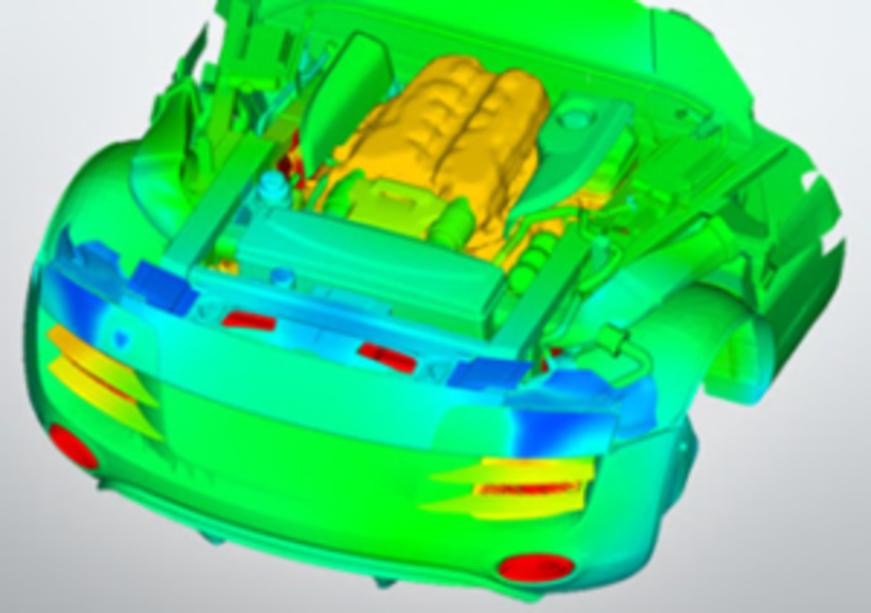Thermal management


In the automotive sector, this can be engine cooling or brake cooling, but it can just as easily be the air conditioning of the passenger compartment, which must be cooled in summer and heated in winter.
In addition to transporting heat, thermal management also serves to optimize performance and minimize consumption. In a transmission, for example, the heat generated must be dissipated, and at the same time the lubrication of all gears and bearings must be ensured. If there is too much oil in the transmission chamber, the efficiency of the transmission will drop.
Heat is mostly transported from one body to another by forced convection.
In heat exchangers, heat is exchanged between two material flows, e.g. air and cooling water. In an intercooler, EGR cooler or air conditioning unit (condenser), heat is also transferred from one medium to another.
The media (material flows) are driven either by pumps (centrifugal pumps, axial pumps), fans, blowers or the airstream.
In some cases, e.g. in the post-heating behavior of a sports car when stationary, free convection (gravity-driven flow) also plays a role. Furthermore, heat conduction and often radiation must often be considered. Satellites, for example, only get rid of heat flows via radiation.

From the simulation point of view, it is mostly a coupled simulation between the flow and the energy (heat. However, there are also approaches in which only heat conduction in solids is considered and the flow is only taken into account via heat transfer coefficients and fluid temperatures as boundary conditions. This can be solved with pure FEM solvers.
Not too hot and not too cold
Thermal management is therefore basically about ensuring that something has the right temperature, i.e. that it does not get too hot or too cold.
If electronic components get too hot, the solder joints melt and the components are destroyed. In the worst case, they start to burn. Brakes lose their braking effect at a certain temperature or the braking effect decreases considerably.
If something gets too cold, for example, cooling water can freeze, seals can no longer function or rigid containers can burst when they freeze.
![[Translate to English:] merkle-partner-thermomanagement-an-einer-Leitplanke [Translate to English:] merkle-partner-thermomanagement-an-einer-Leitplanke](/fileadmin/_processed_/f/a/csm_image005-1-300x194_77a1b0941b.png)
![[Translate to English:] merkle-partner-thermomanagement-an-einem-winkelschleifer [Translate to English:] merkle-partner-thermomanagement-an-einem-winkelschleifer](/fileadmin/_processed_/0/7/csm_image007-1-300x128_22f474a926.png)
Batteries and fuel cells, just like passengers in a vehicle, require a comfortable temperature. The temperature control must be controlled so that the minimum and maximum permissible temperatures are maintained. If an internal combustion engine gets too hot, piston seizure occurs; if an electric motor gets too hot, the strands melt. In both cases, fires can occur.Batteries and fuel cells, just like passengers in a vehicle, require a comfortable temperature. The temperature control must be controlled so that the minimum and maximum permissible temperatures are maintained. If an internal combustion engine gets too hot, piston seizure occurs; if an electric motor gets too hot, the strands melt. In both cases, fires can occur.
What can a simulation look like?
Pure FEM calculation
In a pure thermal calculation, only the solids are wetted.
Fluid temperature and heat transfer value are applied as boundary conditions at the wetting points. These values originate, for example, from sources such as the thermal atlas and were often determined in the past from extensive tests and summarized in formula via similarity considerations.
The only degree of freedom in this case is the temperature.
Calculations can be steady-state (for the run-in condition) or transient (heating up, cooling down). Radiation can be taken into account.
Pure CFD calculation
In the CFD calculation, both the flow fields and the solids are meshed.
The local heat transfer values and the local fluid temperatures are calculated. Here, too, the calculation can be carried out in a steady-state or transient manner. Radiation can also be taken into account.
Coupled CFD-FEM calculation
In this case, there is a calculation of the flow field and a calculation of the structure, which exchange results at specific times. In the process, heat flows from the structural model to the flow model or from the fluid to the solid.
For this we use different solver combinations, e.g. Star CCM+ / TAITHERM.
Here we calculate complete vehicle models with external flow and vehicle flow.
Advantages of the coupled simulation are that also stationary flow conditions can be considered and the solution of the temperatures can take place transiently.
What are the advantages of a simulation?
Via the simulation, the expected temperatures can already be determined without prototypes and optimized if necessary.
In this way, decisions can be made as to whether, for example, an oil cooler is necessary or how the cooling air flows can be optimally distributed between the individual consumers.
Power losses in electronics, power electronics, computers, etc. can be considered and optimized.
Components on printed circuit boards can be optimally positioned and decisions as to whether and how many fans are required can already be determined in the design phase.